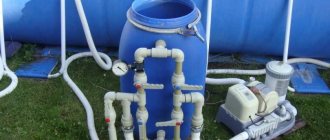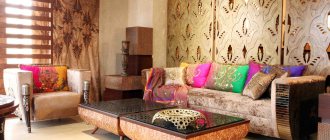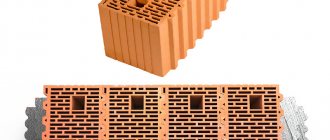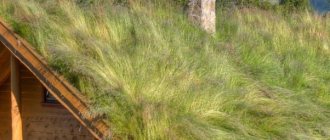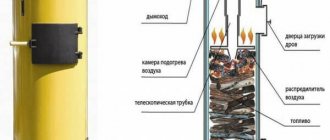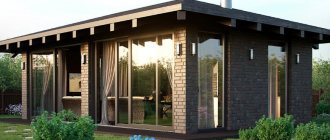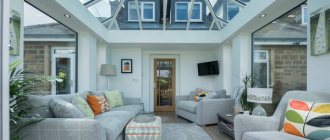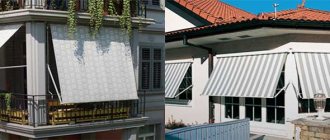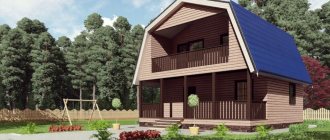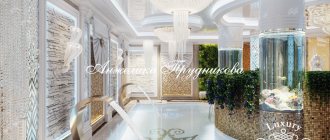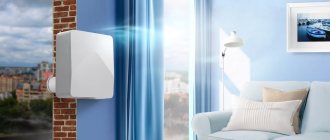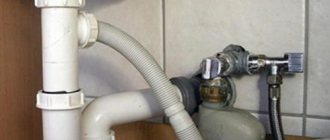Those who go on vacation to seaside resorts often encounter such a phenomenon as a used roof, on which there is not only a solarium, but also a structure for water procedures. Even skeptics find this location convenient and understand that if you build a pool on the roof of a private house, it will save space on the site and provide swimmers with complete privacy. Let's consider how such a vacation can be organized, and how sensible such a decision is.
One of the southeastern hotels with a rooftop pool
Stationary ↑
This type of swimming bowl is comparatively less common on the roof. The design of the pool in this case, in turn, is:
- built-in;
- superficial.
basseyn-1 basseyn-2
Let's look at each of them separately.
- Built-in. The depth of the bowl may vary depending on the available space inside the house. They are built from monolithic concrete, foam blocks or bricks. In this case, waterproofing materials and insulation are used. It should be noted that, as a rule, these materials are needed in large quantities. That is, such structures are distinguished by a rather large mass. The design of pools of this type is carried out taking into account all the necessary parameters and an accurate calculation of the required amount of materials.
- Superficial. They are built on the roof plane, raising the structure to the required height.
rooftop pool photo
Stationary swimming bowls are different:
- Durability. The structure is built only once. It is periodically cleaned and the bowl is filled with water.
- Reliability. The maintenance-free service life is quite long, especially if they are properly equipped and finished.
- Practicality. The design is easy to maintain. Closer to autumn, the water is drained and the bowl is insulated for the winter.
Important In stationary closed structures, ventilation ducts must be thought out. Otherwise, the heated air will create some discomfort for people in the pool.
How to make a swimming pool in a stationary private house: useful recommendations
One of the important aspects of installation is the installation of pipes through which water is supplied and drained. Particular attention is required to sealing pipe connections and areas at risk of flooding of the structure.
- Initially, the depth is chosen, and in accordance with it, the stairs necessary to descend into and out of the water are built.
- When choosing a finish, preference is given to more practical materials that are characterized by
- ceramic tile;
- porcelain stoneware;
- glass mosaic.
- roofing felt;
- film;
- sealant and so on.
- Pipes connected to the bowl are checked for leaks. If they pass along the roof surface, they must be insulated to prevent freezing of the line. Otherwise, the pipes will have to be replaced.
- It is recommended to use plastic pipes in the system. The diameter is selected in accordance with their purpose:
- Waste – 80–100 mm;
- Feeders – 50–60 mm
Attention It is necessary to take preventive measures to block the path of excess water onto the roof and not flood the house. For this purpose, drain pipes are laid along the walls at a calculated angle, through which water from the roof is discharged directly into the pit. As a safety measure, a fence must be installed on the roof
As a safety measure, a fence must be installed on the roof.
The same applies to the construction of structures of the second, surface type.
Frequently asked questions and answers
Realistically, but if you are the owner of an apartment on the top floor, then you can build a swimming pool on the roof of a high-rise building, but only after first obtaining all the relevant permits. What varieties are there? [Close]
There are seasonal and year-round (that is, closed). What type of rooftop pool is usually made? [Close]
The most common option is frame pools. The frame option has one significant disadvantage - labor intensity and financial cost when purchasing a monolithic large bathtub. Are there step by step instructions on how to make a rooftop pool? [Close]
Yes, sure. Similar instructions are provided on our website, go to the website. A rooftop pool is expensive! Is there any economical option? [Close]
For a more economical option, use hydrofilm. A durable film is attached to a frame built from foam block, brick or monolithic concrete - first on the bottom, then on the side of the pool.
Source
Types of structures
Before you start designing and drawing up estimates, select the type of structure. This parameter determines the technology for performing the work and allows you to select the optimal materials.
Main types of country pools:
1Frame - sold ready for installation. They look like a metal base on which a fabric (usually PVC film) is stretched. There are basic and complete sets of swimming pools - with a cleaning system, pump, ladder. Installation and use are seasonal. Waterproofing is required
Frame pool
2Plastic - with polymer bowls. Plastic pools can be purchased ready for installation or ordered to be made to order. Also a seasonal – that is, summer – solution. The plastic pool must be removed in winter to avoid damage to the materials.
Plastic pool
3Stationary - these are monolithic structures for permanent use. We will consider their arrangement below. Yes, building a stationary country pool requires a significant investment of time and money, but in the end you get a working solution that is easy to use. Reliability is high, durability is also good
Stationary pool option
Inflatable pools are also used - but this is a very simple, short-lived material. It’s easy to pierce even the most expensive product, and you’ll have to replace it. Small inflatable products can be placed in the children's area.
Pools with different depths should have a flat bottom with smooth transitions. Sudden changes are unacceptable for safety reasons.
We build a house for a cat with our own hands. Interesting ideas and step-by-step instructions: from plywood, cardboard boxes, fabric. Drawings with dimensions (120+ Photos & Videos)
Advantages and disadvantages
The pool itself, given the name “frame”, is a frame - rod or sheet, the parts of which are securely attached to each other, and then the pool bowl itself is attached to them. The material from which it is made is more than reliable: two layers of vinyl and one layer of polyester create reliable protection that can withstand more than 50 tons of water. This design can compete with stationary pools.
A guarantee that such pools are sufficiently frost-resistant in winter is a steel base with a special anti-corrosion coating. The vinyl bowl itself is also covered with a special frost-resistant film. In winter, you simply empty the bowl of water and cover it with a special awning.
Some manufacturers recommend not to do this either - you can pour water into the pool and when it freezes, polish the surface that appears, as a result you will get a real skating rink at home. By the way, such models do not necessarily need to be dug into the ground in winter, as many believe, the mass of frozen water will give the structure additional stability.
I would like to pay special attention to all-season models, the service life of which can be almost 15 years. The bowl of this model is surrounded by iron sheets, the thickness of which is 0.6 mm
For additional durability, the sheets are coated with acrylic paint on the outside, in several layers, which protects the model from corrosion. The pool can be decorated with various decorative elements, which will make it not only comfortable, but also stylish.
Prefabricated frame pools are also good because their price is significantly lower than a stationary one. Plus - ease of assembly and maintenance. Of course, an inflatable pool is much cheaper than a frame one, but users will agree with the fact that they cannot even be compared in terms of durability. It turns out that the frame model is a kind of “golden mean” between durable and eternal concrete pools, the construction of which requires a lot of effort and finance, and inexpensive, but rather short-lived rubber models.
Those who have already purchased such a frame “home sea” can note the following advantages:
- This design perfectly withstands all temperature changes in the air and exposure to ultraviolet rays. It is not afraid of impacts, vinyl fabric is very difficult to pierce (which cannot be said about inflatable products), and if it occurs to someone to simply break the steel frame structure, he will have to work hard.
- The service life of a frame pool is up to 10 years. The convenience of such an acquisition lies in the fact that it can be installed on a completely imperfect surface.
- The shapes that a frame model can take are quite diverse: polygonal (which is very convenient for a non-standard shape of the site), figure-eight, oval and square, with stairs, with different height and area adjustments.
- A convenient filtration system allows you to quickly and efficiently wash the walls of the pool, unlike stationary ones, where the cleaning process is quite cumbersome and expensive.
Of course, installing such mini-reservoirs also has its disadvantages:
- For example, hydromassage pools, which resemble a Jacuzzi in operation, must be assembled or moved to a heated room in winter.
- For such pools a substrate is required; you can use sifted sand on which PVC plates are laid, which is an additional expense. In addition, if there is grass growing in the area where you intend to install the pool, it will need to be weeded out, otherwise it will begin to rot.
- If you are not sure about the density of the walls of the pool bowl, you can reinforce them with reinforced mesh.
- Dimensions, that is, the massiveness of the structure: for some users it is difficult to move such a pool to another place for a certain time.
- If you decide on a more expensive model - an all-season one, then you will not be able to install it alone; here you need to dig trenches for communications; the base for such a pool must be perfectly level, maybe concrete. Plus - additional costs for the filtration system. But as a result, you will be able to relax in comfort for many years.
Common Mistakes
You shouldn’t assume that if you turn to specialists, you won’t have to check or approve anything. There are often situations when builders fill a pool and do not provide for the placement of an overflow tank. It is located below the artificial reservoir itself (otherwise water will not be able to flow into it on its own). This means that a basement will be required, that is, a technical room for the pool.
It happens that some designers not only forget to take this nuance into account when building an overflow pool, but do not even include it in the project. Therefore, be sure to agree on all the details. If the installation is not carried out properly, then you will have to solve this problem by installing special plastic containers that are designed for a volume of up to 5 tons. If you require more products, you will have to call a specialist who will cook polypropylene directly on site, if the height of the pool allows. It’s not hard to guess that all this will result in another expense item.
Also, sometimes openings for embedded parts are not taken into account. This again happens more often in cases where a detailed design for the future pool is not drawn up. After this, the builder can say that he cast the bowl of the right size, and the rest is not his concern. But in addition to the tank itself, there must also be pipes, and therefore outlet openings in the form of mortgages.
It is important to make sure that the pipes are laid during the reinforcement process, immediately after the first layer has been connected. This applies to those cases when the bowl is not bypassed and is not suspended on special supports. If there are no openings for the mortgages, then you will end up having to drill and chisel the concrete. This will require jackhammers. It is not difficult to guess that their use is most likely to create a lot of cracks in monolithic concrete.
Healthy! Moreover, not only must there be openings, they must be exactly the size specified in the Specification of openings for mortgages. If they are smaller, then the mortgages will not fit into them, which means you will still have to use a bumper.
Advantages of frame pools for summer cottages
A frame pool is an excellent alternative to an expensive stationary pool at the dacha; thanks to the ease of installation, such bowls remain unrivaled for owners of dachas and suburban areas. At the same time, they compare favorably with inflatable models that are in the same price category, since they have all their inherent advantages, but are devoid of their disadvantages.
Advantages of frame pools for summer cottages:
- Complete water activities. Your family will have a pleasant time during the hot summer. They are ideal for children to play with, as they have little depth, and for adults, as they can relax and tone up after a working day. In addition, you can buy a children's frame pool, which is aimed at a depth of no more than 30-45 cm.
- Rich choice. Frame pools are available in a wide range of sizes, shapes and colors, and you can easily find the right model. The same applies to the characteristics of the materials from which the structure is made. In addition, almost any configuration is available to the buyer: despite the fact that the standard kit, as a rule, consists of parts for assembling a pool, instructions and a filter, you can always additionally purchase any equipment that is available on the market in a wide range, for example, this can There should be a convenient staircase for going down to the pool or a children's slide.
- Easy to assemble. The installation algorithm for a frame pool is quite simple. The standard kit always includes instructions in the form of a diagram, and is also often accompanied by a disc with a video of the working process, which simplifies the assembly process. The fastenings of the support elements are thought out to the smallest detail; after 30-60 minutes the structure will be ready for use. The same applies to disassembling the pool if you plan to move it to another site or assemble it at the end of the season.
- Mobility of the structure. The simple technology of assembling a frame pool allows, if necessary, to move it to a new location without disassembling it; you just need to drain the water from it if the selected area is not suitable. For example, when it gets very hot and you want to move the pool into the shade.
- Possibility of transportation. Thanks to the light weight of the structure (about 20 kg on average), a frame pool can not only be easily moved around your property, but also transported to any distance, for example, if you have planned a vacation with a trip to nature.
- Easy maintenance. Thanks to modern pool care products, it is very easy to wash and wipe the smooth surface. To do this, you need standard household equipment; no special equipment is needed. The work is also made easier thanks to the reduced volume of water inside the bowl.
- Reliable water quality control. It is not at all necessary to drain it, because it does not bloom and does not accumulate pathogens. The water quality control procedure is carefully thought out. Its cleaning system is reliable and is not inferior in its characteristics to equipment that is used in stationary concrete containers.
- Mechanical endurance. The fastenings of the frame structure are made quite reliably, which prevents the film from breaking under water pressure after it has been collected into the formed bowl. The same applies to the contact of the material during the assembly of the frame pool with various hard and sharp objects. Also, three-layer polyvinyl chloride is not afraid of point impacts and temperature expansion.
- Durability. The parts of the frame pool are very durable and resistant to the influence of the atmospheric environment, so the product can be used for 8-10 years. Such bowls are not afraid of temperature changes, rain, wind, and the structure of the formative film and frame does not change. All-season models are not deformed by frost; they do not need to be dismantled for the winter.
- Maintainability. If, after all, the pool film is damaged, there is no need to panic: it is not disposable and can be easily repaired. By the way, for this purpose, when purchasing a frame pool for your dacha, you can also purchase a special repair kit.
- Affordable price. We’ll talk about the numbers themselves later, they differ from one manufacturer to another, however, nevertheless, frame frames are a fairly marketable product, because they outperform their competitors in many respects - plastic, composite, concrete and inflatable pools. For example, even a person with a modest income can buy an Intex frame pool from the most popular supplier; such models are inexpensive.
Artificial pond on the roof
In the modern world, exploited roofs are no longer something surprising: as you know, you can even build a parking lot or a helipad on them.
It is quite possible to put a small frame pool on such a roof
In the photo - a built-in pool on the roof of the house
Note: Designing any hydraulic structure is always a rather complex and responsible matter; only a professional should do this. Any mistake can be fraught not only with financial losses, but also downright dangerous for the inhabitants of the house.
Even one cubic meter of water weighs almost a ton, and the smallest pool contains at least 5-6 m3. This is only water, but you also need to take into account the weight of building materials - and this is often solid brick and monolithic reinforced concrete, not counting waterproofing, cladding and the weight of engineering equipment.
So, talking about building a swimming pool on the roof of a private house yourself is simply pointless. But choosing a project if you want to build such a house is a completely different matter.
What types of pools are there?
In the designed building, the pool will be stationary and can be built-in or surface-mounted. The first version of the structure is built into the ceiling, placing the bowl in the room below. In the second case, the pool bath rests on the floor plane and is like a superstructure.
Note: Regardless of the design, the entire weight load falls on the walls (after all, the ceiling also rests on them), and they must be properly reinforced.
Swimming pool as a superstructure
A stationary structure is not only labor-intensive, but also quite expensive in cost. It still makes sense where summer lasts most of the year, and the reservoir is constantly used. And even in the south in winter, this pool can be filled with snow. So for Russian latitudes, the best solution would be a temporary option, which is much easier to install and weighs much less.
This pool is not suitable for the Russian climate
The main thing in this case is that the ceiling is designed for additional load (mainly the weight of water, since the frame pool is very light), which can be discussed with the designer when purchasing the project. There are not many such projects, because such houses are not offered in the standard version, but they still exist. And we will consider one such project of a house with a rooftop pool below.
Project and design
The construction and design of a swimming pool begins with the creation of a phased project. The document provides clarity on the following issues:
- Choosing a location. If the house is intended for year-round use, it is advisable to choose an indoor pool. It is laid simultaneously with the design of the house; If the house has already been built, an extension will be needed. If the owners live in the cottage only in the warm season, an outdoor option is appropriate.
- Sizes and shape. These parameters depend on the purpose of the pool. Will it be only for children or family, will the appearance of friends be envisaged?
Pool in the basementSource st.hzcdn.com
- Location of communications, filter and system and heating.
- Availability of additional options. At the request of the owners, hydromassage, a waterfall, and lighting are installed.
- Development of style, selection of materials for decoration. The design of the pool should be in harmony with the surrounding space. Materials that are not deformed by moisture are suitable for its construction.
In the backyardSource decoratorist.com
Skyscraper in Hawaii
The glass pool jutting out from the seventh floor of the Anaha complex in Honolulu is the creation of Chicago-based architecture studio Solomon Cordwell Buenz (SCB) in collaboration with local firm Benjamin Woo Architects. The latter were responsible for landscape design and swimming facilities. The dizzying view that opens from the pool is a reward for daredevils: the height of the pool is 23 meters. The 38-story Anaha Tower itself is clad in greenish-blue glass to match the Pacific waves. The waves imitate curved walls, offset relative to each other to create sculptural forms. The total height of the building is 122 meters.
How to build a swimming pool in a private house?
A swimming pool in a private home is no longer a luxury item. After all, you can do it yourself. If you have the necessary funds, you can buy the pool itself. However, a person who is a little familiar with construction work will be able to equip such a structure without the involvement of specialists. Before you make a pool with your own hands, you need to figure out what types of pools exist in general, and also learn about the pros and cons of each of them.
All swimming pools can be divided into two types:
Such pools are either located above the surface of the earth, or at least slightly protrude above it. Their distinctive feature is the presence of a frame. These structures are very convenient because they can be easily moved and also dismantled for the winter.
The disadvantage of frame structures is that they are very expensive. Although some craftsmen can make them themselves.
pit
Pool pit
This type of pool is inexpensive and can be made with your own hands without much expense. You just need to purchase concrete and waterproofing materials. The disadvantages of the pit structure are that it cannot be dismantled. Another disadvantage is the large volume of excavation work. After all, the master will have to dig a pit with an area of about 16 square meters.
Not a balcony, but another room
While not everyone would risk taking over the attic, roof or basement of a high-rise building, many do whatever they want with balconies.
But it’s one thing to glaze and landscape a balcony. It is quite another to turn it into an additional room by increasing the balcony slab by several meters and constructing homemade supports that destroy the house. In Makhachkala this phenomenon has become widespread. Someone on the 3rd or 4th floor of an ordinary Khrushchev building, in place of a balcony, built himself another apartment. And there are houses in which the apartment on the first floor took several square meters of common land and made an extension (and also dug a cellar underground), the owners of the apartment on the 2nd floor built on top of it - and so on to the very top. Over the past few years, the Makhachkala Municipal Housing Control Department has been fighting “the expansion of balconies and the installation of additional premises to the house.” Several thousand violations were identified, court decisions were made to demolish and restore the premises to their original form. But there are still a lot of unauthorized piles.
Makhachkala. Photo: press service of the Makhachkala administration
There are also a lot of balcony violations in other cities. In some places the local authorities turn a blind eye to them, but in others they begin to fight. In St. Petersburg, on January 10, 2021, amendments to Art. 18 of the Law “On Administrative Violations...”, under which homeowners can now face claims “for unauthorized changes to the facade, including additional glazing and installation of canopies.” At first, even those who glazed their balcony without approval 10 or 20 years ago were at risk. The fine for citizens is from 1 to 5, for legal entities - from 20 to 100 thousand rubles. Later, punishments were left only for new uncoordinated alterations and those that spoil the historical appearance of the city.
How to make a pool with your own hands from what you have on hand
Everyone knows the proverb about a goal that is cunning. It is fair, of course, not to all people who build something similar at home. There are simple and creative individuals who do not recognize boundaries, but more often than not it hits the mark. Let's see how to make an inexpensive pool.
DIY frame pool from scrap materials - pallets
Let's start with materials close to us. Pallets can be found anywhere. They have standard dimensions (800*1200*144), so this option is suitable for any region.
We begin work by creating a base - this will be a platform for the same pallets. You will need 8 pieces, which need to be laid out in three rows. In the central row, pallets will be laid parallel to the outer ones (2 pieces) to form a bundle.
Pool bases
Then two squares are knocked together from the pallets. They are attached to the structure at the front, creating places for approaching the pool. This entire structure must be built on a level area. If there are unevenness, then boards can be used for leveling. The platforms are laid overlapping - they need to be connected to the base with nails or self-tapping screws.
Expert opinion
Deputy General Director of the Housing and Communal Services and Urban Environment Association Dmitry Gordeev:
— In 2005, the Housing Code of the Russian Federation was adopted, which strictly prescribes issues of redevelopment and reconstruction. Even seemingly ordinary glazing of a balcony is considered a redevelopment and requires approval. Not to mention those cases when homeowners enlarge the balcony slab (it is common property) and erect dangerous structures. What is the penalty for illegal redevelopment? If the owner refuses to return everything to its previous state, the municipality, through the court, has the right to sell such an apartment at a discount (even if it is the only housing), and the new owner must correct the situation.
As for the seizure of the common property of the house (they fenced off part of the corridor, occupied the stairwell, the basement, use the land plot near the house for parking), the Housing Code clearly states this: when reducing the composition of the common property, the consent of all owners of the house is required. Not 70, but 100%. It is impossible to organize this, if only because one person from home may be abroad, another in the hospital, etc.
Types of roof pools
Similar structures installed on the roofs of houses are divided into three types:
- Stationary
- Frame (collapsible)
- Inflatable
Swimming pools can also be outdoor or indoor.
Stationary
Stationary type products are divided into built-in and surface-mounted. The first option is most often designed and built together with the house itself. The second - after the completion of the building, if the strength of the foundation and load-bearing walls allows this.
Brick, concrete, and building blocks are used to construct such structures.
Advantages
- Practicality
. Maintenance of the structure only involves draining the water for the winter period and replacing the filter elements. - Reliability
. A well-made design does not require repairs during operation. It does not need to be reconstructed and leaks fixed every year. - Durability
. When using high-quality building materials, such pools have a fairly long service life.
Frame
The design of this type includes: a metal frame, an elastic bowl, additional components, and, depending on the type, a sliding roof.
Advantages
- Practicality
. A frame pool on the roof of a house does not require any repair work during operation. Only durable materials and a special protective coating are used to make the bowl. - Easy to install
. The products are easy to install and, if necessary, also easy to dismantle. - Versatility
. Possibility of installation not only on the roof, but also in other places; you can also reinstall the product from one area to another. - Durability
. The service life of a product made of high-quality material with a high-quality protective coating is from 10 years. - Economical
. Installing a frame-type pool does not require the construction of an additional foundation or walls, which means significant savings.
Frames for swimming pools are made of stainless steel.
Inflatable
Inflatable pool structures have a significant advantage over other structures - they are easy and quick to install and remove. There are many options for such products: standard inflatable bowls, inflatable pools with additional lighting, and a hydromassage system. At the same time, the soft walls of the structure significantly reduce the possibility of injury as a result of a person colliding with them.
For the production of products, heavy-duty polypropylene and polyethylene are used. They can also have a variety of parameters: depth - 0.5 - 1.5 meters, diameter of the thicket - 3.0 - 5.0 meters.
Polyethylene is not strong enough to install such a pool on the roof of a building.
Therefore, specialized sites are pre-equipped for such structures. The base in this case is polyurethane foam, polystyrene foam.
To fill the rubber bowl, an ordinary rubber hose is most often used. And to drain the water, especially if the container is large enough, an electric pump is used.
Important! Regardless of the type of pool installed on the roof, the main thing is to ensure waterproofing, a slight roof slope, and drains in case of depressurization of the pool bowl. Those who go on vacation to seaside resorts often encounter such a phenomenon as a used roof, on which there is not only a solarium, but also a structure for taking water procedures
Even skeptics find this location convenient and understand that if you build a pool on the roof of a private house, it will save space on the site and provide swimmers with complete privacy. Let's consider how such a vacation can be organized, and how sensible such a decision is.
Those who go on vacation to seaside resorts often encounter such a phenomenon as a used roof, on which there is not only a solarium, but also a structure for water procedures. Even skeptics find this location convenient and understand that if you build a pool on the roof of a private house, it will save space on the site and provide swimmers with complete privacy. Let's consider how such a vacation can be organized, and how sensible such a decision is.
Varieties
A rooftop pool is not only convenient and useful, but also stylish. Agree, if you build a swimming pool on the roof correctly, put sun loungers and deck chairs nearby - you’ll have a resort corner right in your country house or, what’s even more interesting, near your favorite garage. There are many options for making a swimming pool on the roof of your house. The simplest is an inflatable pool, it is mobile and can be moved if desired - from one roof to another, depending on your location. But still, the majority prefer to build a pool on the roof of a house of a more static, permanent nature, so that they can swim at any convenient time and without deflating and inflating, assembling and disassembling. Simple - there is a swimming pool, and it pleases the whole family all year round.
So, country rooftop pools can be divided into two main groups:
- Seasonal.
- Year-round, closed.
The names themselves already speak for themselves - the first option implies a structure that can easily be removed in the autumn-winter period, put in a closet, and when the heat sets in - reassembled. The second option requires a good roof, mainly made of polycarbonate, which will protect the pool even in bad weather.
IMPORTANT! They build stationary ones from a monolith, foam blocks and bricks. In this case, a large number of insulating and insulating materials are used. However, before building such a pool on the roof of a house, it is worth first drawing up a design project, in which all parameters must be taken into account and the required amount of material must be calculated.
Construction of the bowl
The construction of an indoor swimming pool involves extensive construction work:
- digging a hole. It is better to use an excavator, because you will need a fairly large pit;
- filling the reservoir with concrete. A 30-centimeter layer of sand and gravel is laid at the bottom. Next, the bottom is filled with concrete. The next stage is the creation of formwork, laying reinforcement, pouring concrete;
- installation of a fiberglass bowl (if planned), or waterproofing concrete. The concrete must be coated with a solution that opens the pores. A special waterproofing solution is applied on top;
- decoration of the building. The concrete pond is decorated with tiles or decorative stones.
Decoration of the outdoor pool
A swimming pool in a private house on the street is suitable for a family living outside the city, as well as for those who prefer to enjoy swimming in the fresh air. When developing and designing a stationary pool, the following points are taken into account:
Small debris, leaves and twigs pollute the water, so you will need a well-thought-out filtration system, and you can also think about a protective cover.
Bowl of natural contoursSource st.hzcdn.com
Most outdoor pools have a rectangular shape, which is explained by their simplicity of design and ease of maintenance. The rectangular option is practical: it fits easier into the surrounding landscape, it is easier to surround it with a path, or arrange a recreation area.
Classic shapeSource www.flauminc.com
In production, hydraulic concrete is mainly used; the bowl is lined with tiles. The area around the bowl is decorated with concrete or stone tiles, natural or artificial.
In an area with difficult terrainSource st.hzcdn.com
Space for sun loungers and deck chairs can be allocated using wooden flooring made from terrace boards. If you make the flooring large enough and equip it with a canopy, a cozy dining area will be created.
With wooden flooringSource st.hzcdn.com
In order for your time to be enjoyable, you cannot do without several pieces of furniture: two or three sun loungers, a table and chairs. Furniture for a swimming pool in a private home must withstand specific operating conditions, be resistant to moisture and direct sunlight.
With a touch of modernitySource st.hzcdn.com
Summer furniture is often moved from place to place, so it should be light and durable at the same time; Plastic products fully possess this quality. Manufacturers also offer summer wicker furniture made from artificial rattan. Stylish loungers, sofas, and armchairs are ideal for creating a comfortable relaxation area.
Minimalistic solutionSource st.hzcdn.com
About the bath complex with a swimming pool in the following video:
§ The importance of high-quality waterproofing.
Since indoor hydraulic structures are often located inside a building or located in close proximity to it, an important condition for their safe operation is high-quality waterproofing. This is especially true for reinforced concrete and panel structures, which do not represent a complete barrier to moisture. Over time, due to dynamic loads caused by water pressure inside the bowl and soil heaving in winter, temperature changes, microcracks can form in them, through which water will seep and erode the foundation, which is fraught with serious consequences.
Therefore, firstly, it is necessary to ensure that in the manufacture of the bowl, high-strength Portland cement grades 400-500 with waterproofing additives, resistant to frost and immune to the effects of sulfate ions, is used. Secondly, the walls of such tanks from the inside and outside are treated with elastic polymer-cement mastics, for example, Aquamat (Isomat SA, Greece), Ceresit CR 65 (Henkel Bautechnik, Ukraine).
They also provide additional protection provided by penetrating waterproofing. Its essence lies in the application of special compounds, for example, Cem-Kote CW Plus (Gemite, USA), Penetron (Penetron-Russia, Russia), which contain insoluble compounds that clog the pores of concrete. Also, for this purpose, all kinds of polymer films are used, for example, Flagpool (Flag, Italy), Alkorplan (Renolit, Belgium). Particular attention is paid to the joints and seams of the tank.
Pool options for construction on site
- Frame pool - this type of pool is sold in a store and installed on the ground. The kit will include: a ladder, a pump, a cleaning filter and other components. It is easy to assemble; instructions are included with this pool. The downside is that it will need to be dismantled after the summer.
- Inflatable pool – these pools are inexpensive, but they won’t last long. It is unreliable and can blow away from any mechanical stress.
- Plastic pool - this type of pool will also need to be cleaned after the end of summer; it is purchased ready-made.
- A stationary pool - this type of pool will serve you for a long time; you can make it yourself by investing physical effort and money. But it will be worth it!
The first three pool options are sold ready-made, we will not consider them, we will dwell in more detail on a stationary pool, and look at the options from which it can be made.
Apartment at the expense of the attic
Can a tenant “grab” the attic of the house by enlarging his apartment? It turns out yes. One Tatar poetess did just that.
House 9 on the street. Zhukovsky in the center of Kazan of complex design, multi-level, the attic is on the same level as the poetess’s apartment. So she cut a door in her kitchen. So her “one-room apartment” turned into a “three-ruble apartment” with an area of 120 m². Neighbors, hearing the sounds of renovations, at first thought that the leaking roof was being repaired. But then they raised the alarm: the load-bearing walls in the attic were demolished, part of the rafters disappeared, the ventilation was damaged, etc. A war began between the invader and the rest of the residents. It turns out that she officially attached the attic to the apartment by court decision. However, an investigation by law enforcement agencies showed that the documents submitted to the court were fake: the BTI employee told the police that she was not the one who signed the registration certificate. The woman eventually sold the apartment, and after several years of struggle, the attic finally returned to common property.
Someone who lives on the roof. Is it possible to turn the roof into a personal dacha? More details
Other private pool options
Frame systems
Such structures are constructed from wood with finishing cladding of tin or aluminum. Aluminum sheets have an attractive appearance and are superior to tin in terms of reliability and service life.
The frame straps are made from pine timber. Intermediate parts can be made from any thick, high-quality boards. To provide additional rigidity to the structure, braces made of strong boards are used.
Metal pool
Among the main advantages of frame pools, it should be noted that there is no need to carry out large volumes of excavation work and the possibility of dismantling the structure during the cold season.
Changing the water in such a pool is carried out using a flexible garden hose, which can be conveniently fixed at the bottom of the tank. Waste water from the pool can be used to water the garden.
All joints of the frame structure are subject to mandatory sealing. To give the structure the required tightness, even ordinary polyethylene film is well suited.
Wooden elements must be treated with an antiseptic.
The installation of frame pools usually costs less money compared to the cost of erecting a monolithic structure, while such reservoirs have a fairly solid appearance and fit well into the design of the site.
Pools made of PVC film
Pools made of PVC film
To arrange a pool, if desired, you can even use ordinary polyvinyl chloride film. This material has a rather attractive appearance and acceptable performance characteristics.
The film tolerates contact with water normally, ensures proper tightness of the structure and allows you to save on waterproofing the reservoir.
Even if cracks appear in the container, a properly installed polyvinyl chloride film will retain water.
PVC film can be used both when arranging a new reservoir and when repairing an old pool. Moreover, to build such a structure, there is no need to carry out extensive excavation work: the elements of the film are simply fastened together using the temperature welding method, resulting in a very durable bowl.
The pool is installed on a pre-prepared base and fixed with a frame made of boards.
Characteristics of inflatable pools
Inflatable pools are also practical in their use. They are easy to install and remove. They are made from durable elastic polyethylene. The walls of this design are soft and well suited for bathing children. The bottom is also inflated, which allows you to avoid injuries during active recreation in the pool.
Pool sizes vary. They can be deep and reach 1.2 m. Or they can be 50 cm deep. It all depends on who exactly will swim in the pool, adults or children.
The diameter of the bowl can reach three meters. There are also small-sized designs. Such a pool can easily be placed on the roof of a house.
An example of an inflatable pool on the roof of a residential building
It is worth considering that the structure is made of polyethylene, which stretches during the inflation process, which means it is necessary to monitor the integrity of the pool to avoid its deformation in case of punctures and cuts.
It is for this reason that it is necessary to prepare the site for installing the pool. For this purpose, sheets of foam or polyurethane are used. They are laid out close to each other and securely fastened together with special glue and sealant. Then their surface is laid with roofing felt. A thick carpet or any other material that has a soft structure is already laid on it.
This type of rooftop pool can be filled using hoses or using available equipment.
But it is better to provide drainage with special equipment: pumps and other devices. Moreover, the water will be drained directly into a drainage pit, into which pipes of a certain diameter are first laid. It would also be useful to provide drainage holes on the roof, since if the pool sheet breaks or due to excess water, the structure will be flooded.
